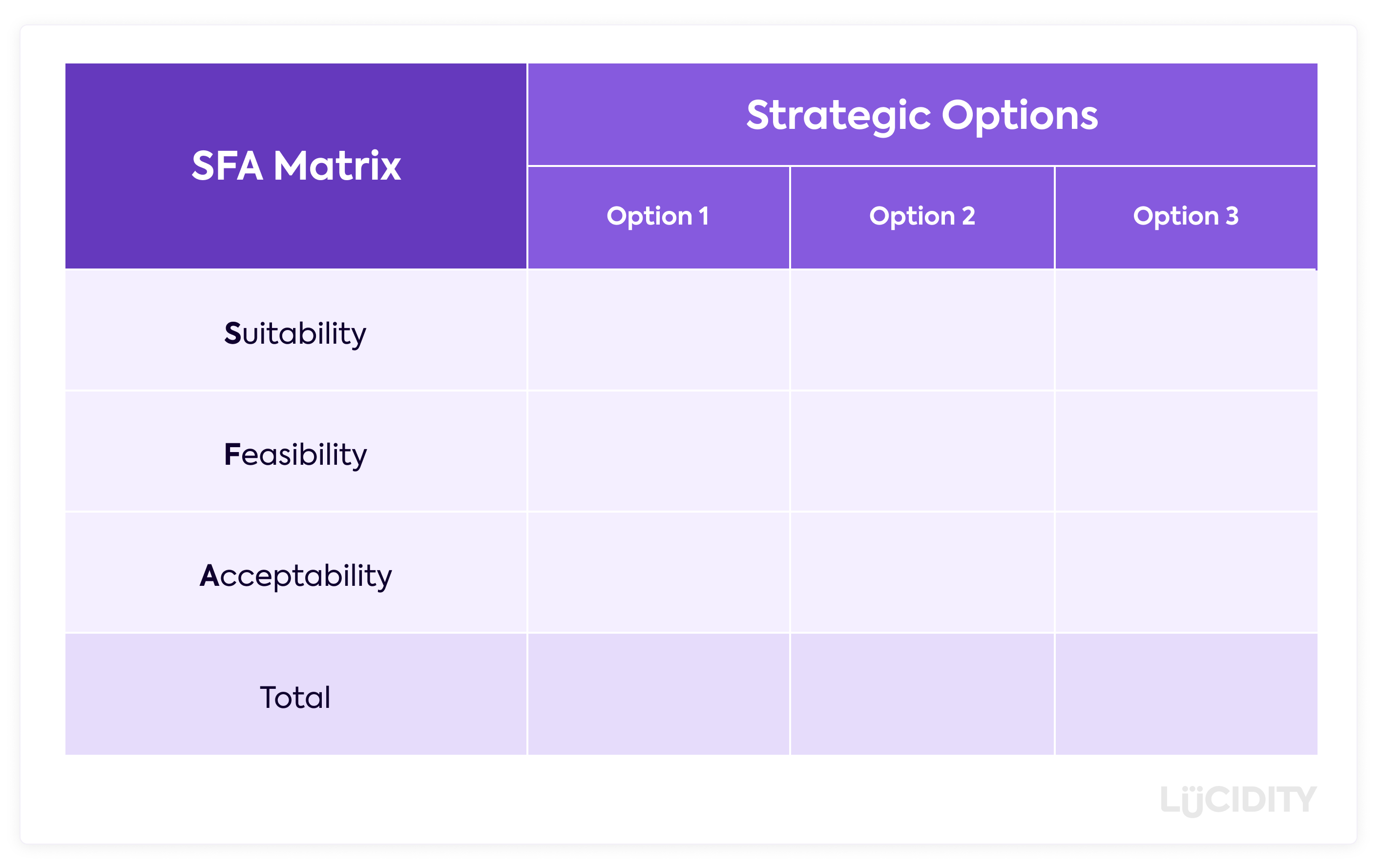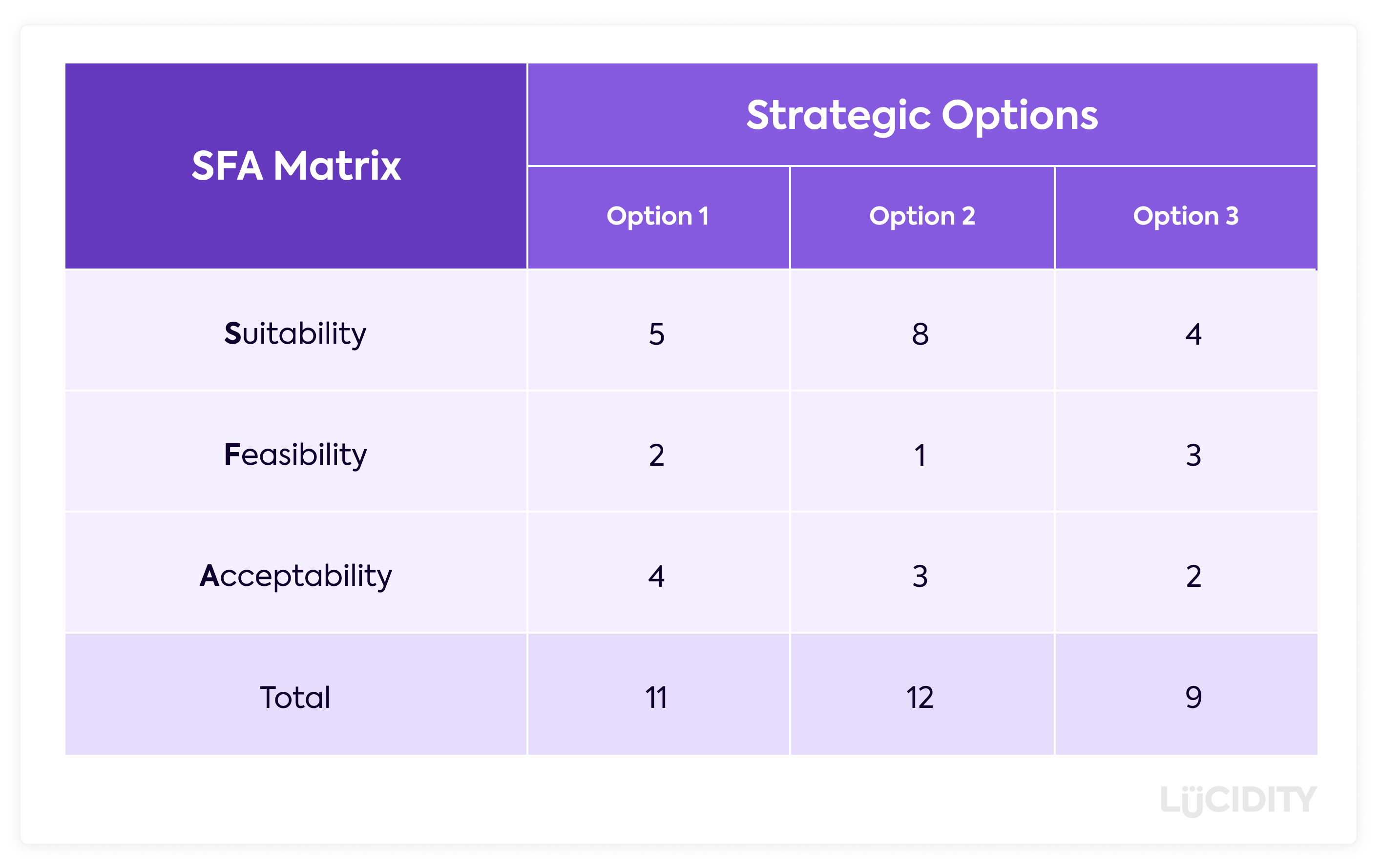As an organisation you’ll have a lot of strategic options and it can be difficult to know which one will ultimately produce the best outcome. We’ve previously looked at examples of strategic planning in areas such as diversification or market penetration, this guide will look at one way you can evaluate different strategic options.
What is the SFA Matrix?
The SFA Matrix is a framework to evaluate your strategic options in order to pick one. SFA stands for Suitability, Feasibility and Acceptability. These are the criteria areas in SAF Analysis used to judge and score each strategy.
How do you use the SFA Matrix?
The SFA Matrix is a simple scoring system where you list out your potential strategic options and score each of them against Suitability, Acceptability and Feasibility. Using the SFA Matrix is often referred to as conducting a SAF Analysis.
What are the steps of SAF Analysis?
Performing a SAF Analysis for strategic options has three steps. Firstly, decide the criteria important to your business in the Suitability, Acceptability and Feasibility. Secondly, decide what your strategic options are for your business. Finally, produce the scores for each potential strategy against your criteria.
In more detail…
Step 1: Decide the Criteria
Deciding the criteria that is important to your organisation is the first step in SAF Analysis. Work through each of the topic areas and list out the key elements.
Step 2: Decide your Options
You’ve probably already done this, but make sure you have listed out your strategic options in order to evaluate them. If you haven’t generated some options take a look at the Ansoff Matrix, Porter’s Generic Strategies, or Bowman’s Strategy Clock for ideas.
Step 3: Decide the Score
Work through each of the strategic options in order, going through the SFA Matrix and scoring each strategy against the classification. Use the analysis you’ve done in frameworks such as SWOT, PESTLE Analysis, and [Five Forces]() to provide evidence against your scoring.
Once done, SAF Analysis suggests the strategy that scores the highest is the best option.
How do you evaluate Suitability in the SFA Matrix?
Suitability looks at if a strategy will achieve the goals you have as a business. It’s a really important question to ask because ultimately you are producing a strategy to hit certain objectives and goals.
The ultimate question in Suitability is: Does the proposed strategy address the key opportunities and threats the organisation faces?
Suitability can have a wide range of topics. You should consider the suitability of the strategy to hit the goals and objectives, but also if it is a suitable strategy for your culture, the environment and market, and capabilities.
The SFA Matrix is best used with other frameworks, so here’s an example of the type of Suitability questions you might ask if you’ve completed a SWOT.
Key Questions:
- Does the strategy take advantage of the Strengths?
- Does the strategy reduce the Weaknesses?
- Does the strategy take advantage of the Opportunities?
- Does the strategy address the Threats?
How do you evaluate Acceptability in the SFA Matrix?
Acceptability in SAF Analysis focuses on the views of the stakeholders. Stakeholder management is an important aspect of strategy, not least because you need to make sure everyone is positive and aligned.
Acceptability looks at the areas of risk, return and reactions. Some key questions to ask about the strategy include:
- Does the proposed strategy meet the expectations on the stakeholders?
- Is the level of risk acceptable?
- Is the likely return acceptable?
- Will stakeholder reactions be positive?
Like Suitability, Acceptability is interconnected to your strategic objectives and goals. What are the returns you’ll get from this strategy and what is the level of risk that those returns won’t happen?
Although the levels of return or risk may not be solely financially related, they could also be around brand or reputation, Acceptability is often related directly to the figures. Therefore frameworks such as Five Forces, which looks at profitability, and PESTLE Analysis are useful tools to work on prior to establishing the Acceptability of a strategy.
If the strategy is looking to expand overseas, consider CAGE Distance and LoNGPESTLE as the complementary analysis.
How do you evaluate Feasibility in the SFA Matrix?
Feasibility is really key because it essentially asks if the business is able to execute the strategic plan effectively. You may consider resources, skills, timing, market changes, access to finance and more when evaluating this part of SAF Analysis.
Some key questions are:
- Would the proposed strategy work in practice?
- Can the strategy be financed?
- Do people and their skills exist or can be obtained?
- Has the planning been done to support the strategy?
- Can the required resources be obtained and integrated?
- Is the structure of the organisation fit for the strategic plan?
What are the advantages of the SFA Matrix?
The advantages of the SFA Matrix are:
- It provides a way to structure strategic evaluation
- It can help strategic decision making
- It is fair as each strategic option is evaluated against the same score
- It is a flexible model so management teams can create their own scoring
What are the disadvantages of the SFA Matrix?
While not disadvantages as such, you should consider the following:
- It requires analysis to be done beforehand otherwise it is not effective
- It can be time consuming when you have a lot of strategic options
- The scoring needs to be done in an unbiased manner
- If two strategies score the same or are close you need a way to decide
Who invented the SFA Matrix?
Gerry Johnson and Kevan Scholes developed SFA Matrix.
What frameworks work well with the SFA Matrix?
SAF Analysis usually occurs at the end of your strategic planning, once you have performed your strategic analysis. Therefore frameworks like SWOT, PESTLE Analysis and Five Forces work well. Given the requirement for objectives and goals, SOAR Analysis is also complementary to the SFA Matrix.















